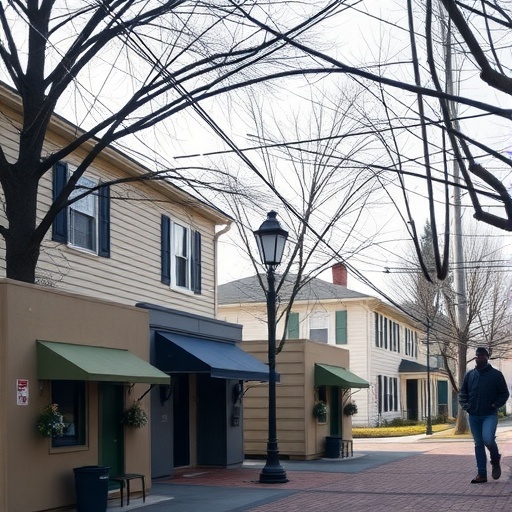In an era where mental health is recognized as a critical pillar of societal well-being, new research sheds light on the intricate relationship between neighborhood social environments and psychiatric disorders. A groundbreaking longitudinal study, conducted by researchers from Karolinska Institutet in Sweden and University College London (UCL), explores how varying levels of social capital within communities influence the incidence of major psychiatric disorders, particularly psychosis and bipolar disorder. The study, published in Nature Mental Health, leverages an unprecedented dataset encompassing over 1.4 million residents of Stockholm County, tracked for as long as 15 years.
This comprehensive investigation centers on the notion of social capital, specifically dissecting three dimensions: political trust, welfare trust, and personal trust. Personal trust, defined as the subjective experience of feeling safe and supported within one’s immediate neighborhood, emerged as a pivotal factor linked to mental health outcomes. However, the findings reveal a nuanced and complex relationship conditioned by the ethnic and geographical origins of residents, challenging any simplistic assumptions about the uniformly protective nature of social connectedness.
Among residents of Swedish or broader European descent, high personal trust in their neighborhood correlated with a lowered risk of developing psychotic disorders as well as bipolar disorder without psychosis. This protective effect aligns with existing theories that posit strong, supportive social networks foster resilience against serious mental illnesses by reinforcing psychological stability and mitigating stress. Nevertheless, this reassuring narrative diverges sharply when accounting for individuals with parental backgrounds from North Africa or the Middle East, for whom elevated personal trust correlates paradoxically with heightened psychosis risk.
This counterintuitive finding demands a closer examination of the underlying socio-cultural dynamics. The researchers hypothesize that measurement biases may partly explain the divergent outcomes. Since personal trust scores were primarily derived from responses within the Swedish-born parent cohort, they may inadequately capture the lived experiences and social integration of minority communities. In turn, North African and Middle Eastern residents might not perceive or access neighborhood trust and safety in the same manner. Structural obstacles to inclusion and social networks could compound feelings of exclusion or stress, counteracting any general benefits of social capital.
Dr. Anna-Clara Hollander, an associate professor at the Department of Global Public Health and one of the co-authors, emphasizes that developing truly inclusive social environments is fundamental for public health advances. “High personal trust in a neighborhood does not automatically translate to advantages for all demographic groups,” she explains. The team stresses the urgency of cultivating equitable, culturally sensitive community frameworks designed to promote mental well-being across increasingly diverse populations—a pressing challenge for urban planners, policymakers, and social scientists alike.
The study’s scale and duration set it apart from prior research, utilizing individual-level data from Sweden’s comprehensive population registries linked to neighborhood identifiers. This allowed for robust control of confounders and stratification by ethnic background, providing unprecedented granularity in understanding psychiatric disorder etiology in social contexts. While political trust (confidence in governmental institutions) and welfare trust (belief in social security systems) showed no clear connection to mental health outcomes, the differentiated impact of personal trust underscores the critical role of social cohesion at the micro-community level.
Importantly, the authors caution against interpreting these associations as definitive causality. The observational study design, while powerful in longitudinal scope, cannot fully disentangle complex reciprocal influences between mental health and social environment. For example, individuals predisposed to psychosis might experience social withdrawal or exclusion, thus influencing neighborhood trust dynamics. Future research will require sophisticated causal inference techniques and qualitative studies to deepen mechanistic understanding.
This research also intersects with a growing body of evidence documenting heightened psychosis risk among migrants and ethnic minorities in high-income countries. Prior studies suggest that residing in enclaves with larger co-ethnic populations may mitigate this risk somewhat by providing supportive social networks and buffering discrimination. However, the current findings nuance such interpretations and highlight that the subjective perception of neighborhood trustworthiness does not uniformly benefit all ethnic groups.
Collaboration with Region Stockholm provided critical epidemiological expertise and data access, facilitating this large-scale investigation. Funding was jointly provided by prestigious institutions including the Swedish Research Council, Forte, the Wellcome Trust, and the Royal Society. Disclosures from lead author James B. Kirkbride note consultancy engagements unrelated to the study, underscoring transparency.
In light of these insights, public health initiatives must prioritize fostering inclusive social capital that genuinely resonates with diverse community members’ lived experiences. Efforts to increase personal trust should be accompanied by strategies addressing structural inequities, discrimination, and societal exclusion, which profoundly impact mental health trajectories. This multidimensional approach is essential to ensure that neighborhood social environments act as protective sanctuaries rather than sources of additional stress.
Future research avenues include replicating these findings in other multicultural urban settings and integrating qualitative perspectives to elucidate the nuanced perceptions of trust within ethnically diverse populations. Moreover, longitudinal interventional studies aimed at boosting inclusive social capital could verify potential causal effects on mental health outcomes, paving the way for evidence-based urban and social policy reforms.
In conclusion, this landmark study illuminates the dual-edged role of neighborhood-level trust in psychiatric disorder incidence, underscoring the complexity of socio-environmental influences on mental health. It highlights the imperative for tailored public health approaches that respect and address cultural diversity within urban societies to foster wellbeing equitably. As urbanization and migration continue reshaping demographic landscapes globally, such nuanced understanding will be vital for mitigating the global mental health burden.
Subject of Research: People
Article Title: Longitudinal association between neighborhood-level social capital and incidence of major psychiatric disorders in a cohort of 1.4 million people in Sweden
News Publication Date: 20 October 2025
Web References:
https://www.nature.com/articles/s44220-025-00518-z
http://dx.doi.org/10.1038/s44220-025-00518-z
Keywords: Health and medicine; Social sciences; Psychological science; Social psychology; Psychiatry; Psychiatric disorders; Psychotic disorders; Psychosis; Bipolar disorder; Health equity




